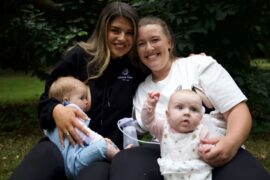Neuroscience
Neuroscience research2 has identified the vital role of the hormone oxytocin in the development of mother-child bonding. Released in the brain, and elsewhere in the body, in response to pleasurable interactions, including breastfeeding, findings show higher oxytocin levels in infants that receive lots of maternal attention, compared to those that receive less. When breastfeeding is maintained over several years, the repeated daily opportunities for maternal attention and pleasurable interaction that are integral to breastfeeding are multiplied many times over. But there’s more to this hormonal story. Oxytocin is also released in the mother’s brain and body during breastfeeding. The oxytocin-triggering joy and satisfaction in breastfeeding that mothers experience is magnified by a perception of their child’s response to being breastfed, and the child’s oxytocin-releasing joy is, in turn, magnified by a perception of its mother’s delight. The breastfeeding dyad is thus symbiotically-attuned in a joyous, mutually reinforcing, emotional synchrony, coasting on oxytocin-surges engendered by shared pleasure and delight. No wonder kids love it!
Positive emotions
Research has also underlined the importance of joyous, pleasurable experience in the early years for neural growth. Both Attachment Theory and neuroscience emphasise the importance of maximising positive emotions. As we have seen, breastfeeding is a source of joy and pleasure for children; they relish the taste of human milk and the emotional importance of breastfeeding to them is revealed in the affectionate names for breasts and breastmilk that children coin, as well as in demonstrations of affection for the source of the milk they love. Breastfeeding also often entails enjoyable play between mother and child.
He can’t really talk, but he sometimes sucks until the milk lets down and then pulls off, laughing as it sprays in his face! England. Ch1: bfdg 1.4yrs.
She used to have a very entertaining relationship with my breasts – talking to them, patting them, making jokes about them. Scotland. Ch 1: bfd 4.10yrs; Ch2: bfdg 1.7yrs
Negative emotions
Again, both Attachment Theory and Neuroscience stress the importance of diffusing negative emotions. According to Attachment Theory, a young child is developmentally unable to regulate itself and is therefore dependent on intervention. When a child’s needs are not met, or when negative emotions go unmodulated, insecure-attachment is the likely outcome. Oxytocin is believed to work by reducing stress – oxytocin neutralises the stress hormone cortisol. While cortisol has a positive role to play in the development of resilience and coping mechanisms, elevated levels for too long, or to too high a level, can have deleterious effects. Early oxytocin-deficiency can lead to greater stress-reactivity in later life. Low levels of oxytocin can lead to less inclination to seek social interaction. It’s now common-knowledge that social interaction is protective of health and that high or prolonged stress impairs health. Deficiency in oxytocin, or in the number and quality of oxytocin-receptors, can have a negative impact on the central nervous system, with behavioural consequences, in both childhood and in later life – personality disorder and social dysfunction may result. Oxytocin-deficiency may even be implicated in schizophrenia and autism. Increased levels of the cortisol occur in episodes of crying and distress. Stress hormones can affect oxytocin-receptor binding in the central nervous system. High cortisol levels are linked to developmental delay. When stress and distress are prolonged over time, it can result in a reduction in size of hippocampus – the hippocampus is involved in learning and memory storage
Western culture tends not to attach much importance to distress in children and regards crying as an unavoidable aspect of childhood. Is this true? Let’s consider two distress scenarios common in the lives of most children. For those lucky enough to be breastfed at all: weaning. Young children are often highly resistant to being weaned. It can be a distressing, even traumatic experience for all concerned and it can be a very prolonged process. From my survey, it is clear that many children are left with long-lasting feelings of loss and longing for the breast. The other scenario: the ‘terrible twos’, which, as we know, can begin as early as 18months and go on well into the fourth year. Tantrums – high-stress, cortisol-raising episodes – are also generally regarded as unavoidable. Are they? The answer to both questions is ‘no’.
Exceptions are inevitable but, as a generality, long-term breastfed children rarely cry and first-time sustained-breastfeeding mothers are delighted to find the ‘terrible twos’ are usually not terrible at all. Many mothers report not even a hint of a tantrum. Should a tantrum begin (or other distress occur) mothers, equipped with their prolactin-laden, oxytocin-inducing breasts, are quickly able to neutralise distress, calm their children and quickly restore equilibrium.
If I were to choose one word that characterised my daughter throughout her childhood, it would be ‘serene’. Tantrums were non-existent. England. Ch1: bfd 6.6yrs.
For a baby who was so stressed-out from the earliest moments of his life (surgical procedure for tongue-tie), he was calmed easily with nursing – and it sure calmed him down when he was injured or really mad. USA. Ch1: bfd 5.3yrs.
I often referred to breastmilk as the ‘mood enhancer’ because it was remarkable how it could change their mood. The transformation was astonishing and immediate. Republic of Ireland. Ch1: bfd 5yrs; Ch 2: bfd 5.3yrs.











Thanks you for such a beautiful and important article! i dont feel so alone anymore! my todler 2.3 years old and still bresatfed! <3
Thank yoy